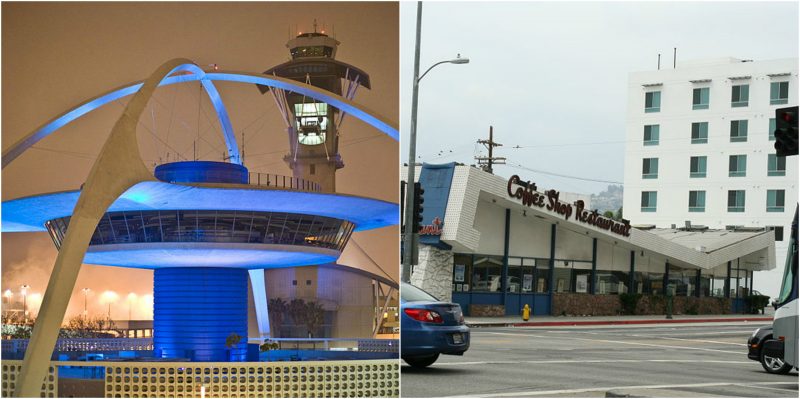The ideas and values of certain periods in our history are often expressed through architecture. Since antiquity, every civilization has expressed its values and principles in buildings. The designed structures are the medium through which cultures are communicated to future generations.
One such style is Googie architecture. It marked the atomic age, the space age, of the last century. It was born during the rise of the car culture, and it was inspired by humanity’s venture into space.
The foundations of Googie architecture can be traced to the Streamline Moderne architectural movement, which flourished in the 1930s. During these years, cars began to dominate the streets of the major cities. This completely changed the way people traveled from place to place and performed daily tasks. New industries rose that specialized in providing services to car owners. Cities grew, spreading outward. Things weren’t concentrated in the downtown anymore.
Suburbs appeared, surrounding the city, offering the same commodities as people living downtown possessed. All of these new businesses were designed to be easily accessible by car.
The decentralization of businesses demanded a change in the architectural style of buildings. Communication became more important, so buildings became more noticeable and expressive. Buildings looked more like “functional signboards.” Streamline Moderne was perfect for the job, because it was sleek and expressive. The buildings contained large columns and round edges and they were illuminated by attention-drawing neon lights. The shapes, together with the illumination, were a perfect symbol of the new age of mobility and energy.
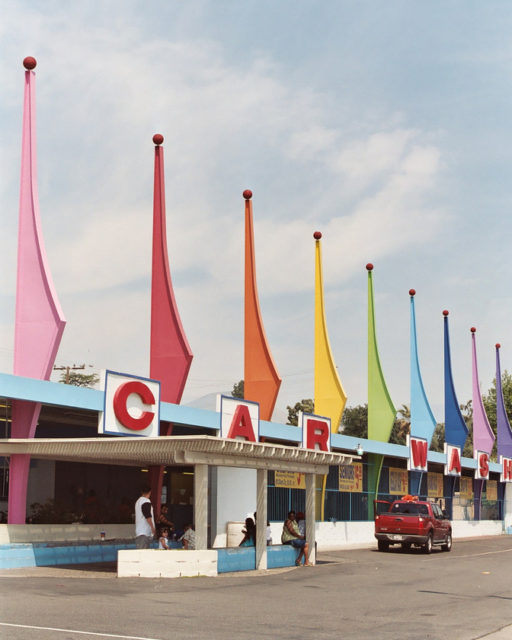
The 1950s brought even more innovation. Nuclear power was used around the world, and space exploration inspired people to think about the future in new ways. These ideas were reflected in the new design style of Googie architecture. Shapes and elements such as atomic explosions, boomerangs, and boldly expressed diagonals started to appear on objects and structures. Instead of looking ordinary, buildings resembled spaceships, nuclear missiles, and power plants. Although these buildings started to attract the attention of drivers as early as the 1940s, the trend was at its peak in the 1950s.
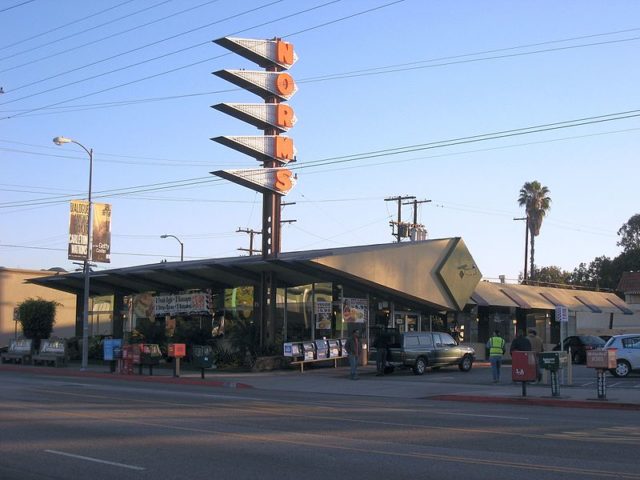
You’re probably wondering how this new architecture got its name.The story begins in 1949, in West Hollywood, where architect John Lautner created a coffee shop called “Googies.” This new venue had all the elements that would later become the standard for coffee shops and drive-ins around the country. “Googie” was the nickname of Lillian K. Burton’s family. She was the wife of the original owner of the coffee shop, Mortimer C. Burton. This architectural gem stood at the corner of Sunset Boulevard and Crescent Heights in Los Angeles until it was demolished in 1989.
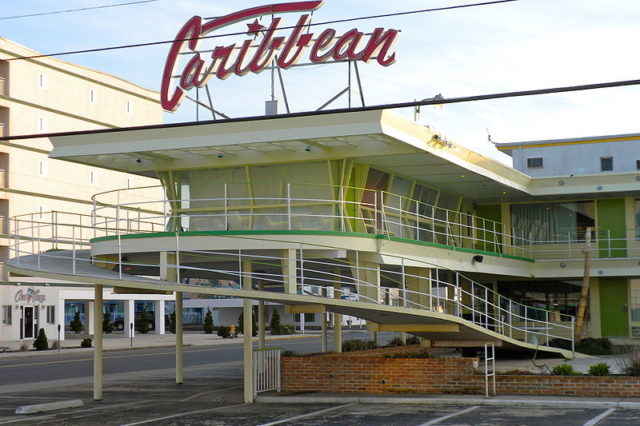
One day, while Douglas Haskell and Julius Shulman of the House and Home magazine were driving around Los Angeles, Huskel told Shulman to stop the car in front of Googies. He declared: “This is Googie architecture.” The name Googie became popular after Haskell’s article about the architectural style was published in a 1952 edition. Haskell may have come up with the name of this architecture but it turns out he wasn’t fond of it. His article criticized and mocked it.
It is hard to pinpoint the first architect who deliberately started to design in the style, but many historians think that the honor belongs to Wayne McAllister. He was one of the earliest architects to start making Googie-style buildings. In 1949, he designed Bob’s Big Boy restaurant in Burbank, which had all the elements of Googie. Later, McAllister worked with many different coffee-shop owners and designed the distinctive look of their chains. Besides him, there were many other productive and influential Googie architects, such as Douglas Honnold, John Lautner, Louis Armet, Eldon Davis, and Helen Liu Fong. Fong, who worked together with Armet and Davis in the Armet & Davis firm, created many iconic Googie interiors, including Johnie’s Coffee Shop on Wilshire Boulevard and Fairfax Avenue and the Holiday Bowl on Crenshaw Boulevard.
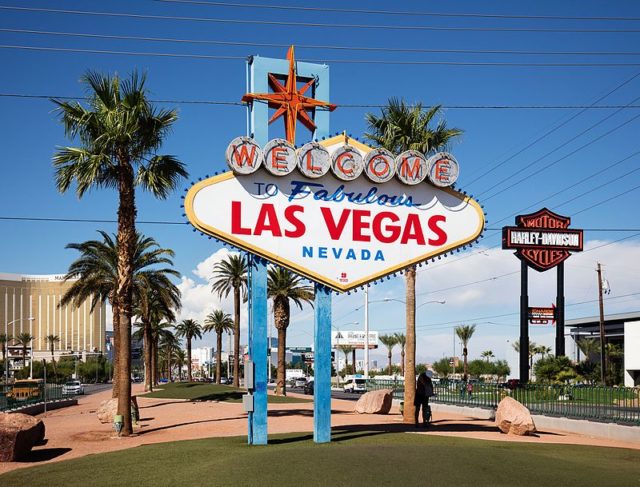
Googie architecture can be recognized by several design elements. It is characterized by its sharp angular shapes that make the buildings look like space rockets, a technology that was rapidly evolving. Googie buildings were often cantilevered, shaped like boomerangs, and decorated with plastic elements in a variety of forms.
Googie buildings are eccentric. Perhaps their oddest element was the roof, which was often sloped and rotated in stark contrast to the standard roof: upward instead of downward. In a way, the roof of a Googie structure was its signature. When we look at examples of Googie architecture, the roofs are one of the first things to draw our attention.
Another interesting decorative element present on many Googie-style buildings is the “starburst” symbol, inspired, of course, by the Space Age. One of the most iconic uses of it is probably the starburst on the “Welcome to Fabulous Las Vegas” sign.
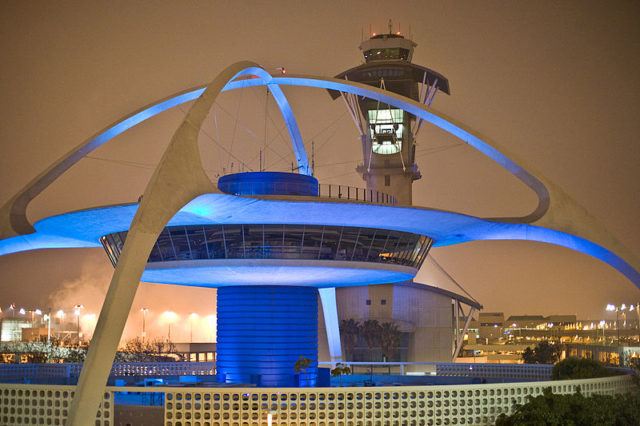
The boomerang shape that we previously mentioned is also a symbol of Googie. It was either used as a substitute for pillars or simply as a decoration. This Googie element was also inspired by science; it was an artistic representation of a directional energy field (the movement of electrical current).
The magic of Googie architecture was in its abstract look and geometrical representations of existing objects and living things. If a Googie architect wanted to represent a bird with his design, the whole building would look like a geometrical bird. Another aspect of the charm of Googie Architecture was its tendency to defy the laws of gravity. Buildings were often designed to look as if they were suspended and hanging from the sky. All of this contributed to its futuristic appearance.
There are many buildings that could be considered as representative of Googie architecture, but unfortunately, are now gone. One of the most famous Googie architecture examples still in existence is the Theme Building at Los Angeles International Airport, which was designed by James Langenheim in 1961. The main terminal at Washington Dulles International Airport, created by Eero Saarinen in 1958, is another example of Googie still standing today.
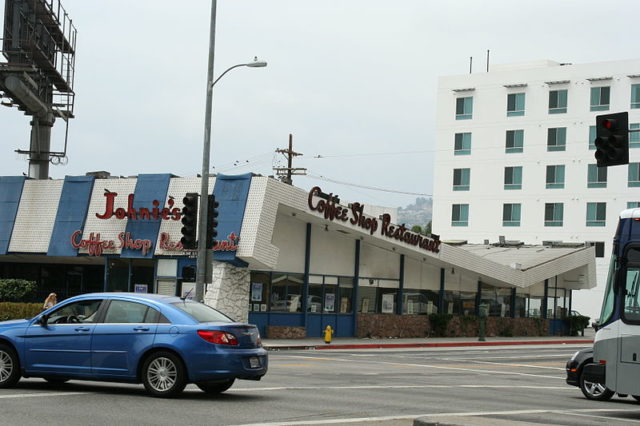
Although the Googie architectural style is rarely used today, we can see its influence everywhere, especially in movies and cartoons that deal with the genre of retro-futurism. The Jetsons cartoon series is probably the best example of Googie architecture used in an imaginary futuristic world. We can see other examples of Googie architecture in Jimmy Neutron, the legendary Futurama series, as well as in The Powerpuff Girls.
Just around the corner of Wilshire Boulevard and Fairfax Avenue in Los Angeles, you can see Johnie’s Coffee Shop. Its name doesn’t say a lot, but this Googie-styled building and its interior have been the set for many famous movies, such as Miracle Mile, The Big Lebowski, Reservoir Dogs, Gone in 60 Seconds, and American History X.
Googie Architecture had a tremendous impact on our culture, and it will always be remembered as an architectural style that made us think out of the frame and look toward the future, ready to reinvent our societies and cultures.
